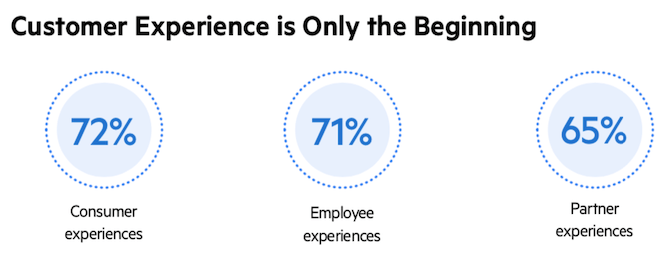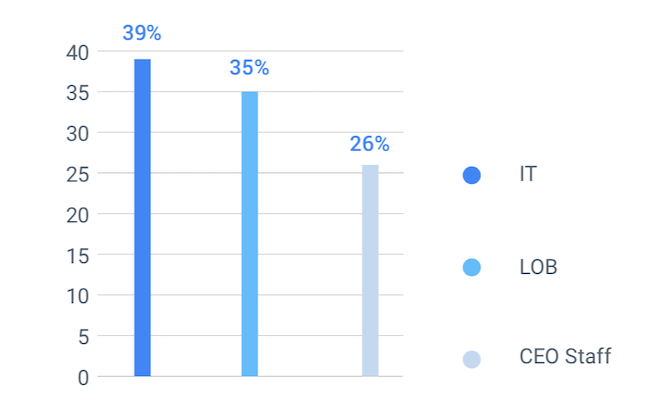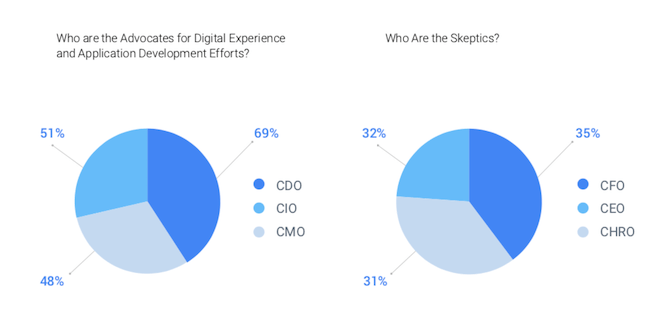Why Don’t More Digital Experience Projects Get Off the Ground?

Innovations in digital experience can be hugely beneficial for organizations. However, research shows that 90% of these digital experience projects fail to get off the ground. In this post, we’re going to look at why that is and how you can remove those obstacles to progress.
Digital experiences are any interactions that prospects, existing customers, employees, and business partners have with a company through technologies like websites, apps, and marketing channels. And we’re seeing some growth in terms of digital experience projects as a result.

The State of Digital Experiences report reveals that the majority of organizations recognize how critical it is to meet the demand for digital experiences. 93% of respondents, for instance, agree that the coordination of digital marketing and app development has the ability to greatly improve business outcomes.
Now, the good news is that 79% of respondents have received approval to move forward with digital experience projects.
The bad news, however, is that 90% of respondents have delayed or cancelled their digital experience projects over the last year.
If digital experience is such a high priority for organizations, why do so many projects get put on the back burner? Today, we’re going to explore some of the common challenges related to designing digital experiences and how to get past them.
How to Keep Your Digital Experience Projects from Getting Delayed or Cancelled
The most common barriers to completing digital experience projects are:
- Technical complexity
- Budget, skills, and resources
- Reliance on IT to delivery strategy
- Lack of clarity on who owns the digital experience
- Cultural resistance to change
Here’s what you can do to navigate these challenges:
Do Away with Incompatible Tech Stacks
When we talk about incompatibility in a tech stack, there are a number of things that could be amiss.
For starters, digital experience projects very rarely involve just one person or team. As a result, each department may bring their own set of tools to the table. But when teams work from disparate systems, collaboration and consistency become very difficult and costly to achieve.
There’s also the matter of legacy systems getting thrown into the mix. The whole point in building digital experiences is to transform an organization into something more agile and powerful. But older systems inherently get in the way of that.
Unfortunately, 66% of top organizations still rely on traditional web content management systems (WCM/CMS) as opposed to only 34% who use digital experience platforms to manage their projects.
Then, there’s the problem of usability. Whether a digital experience team uses the same tech stack or not, none of that really matters if the tools they’ve chosen can only be used by a select few.
Roughly a quarter of the survey’s respondents said that their marketers depend on IT to update their content as they’re unable to do it on their own due to technological limitations.
The Solution
It seems silly to try to build digital experiences for customers and internal teams when you’re working with the wrong tech stack. And, yet, it looks as though that’s what many organizations are trying to do.
The solution is simple:
Improve your technology before you try to build technology for your customers or team. And when it comes to digital experience, this means choosing a single digital experience platform that everyone is comfortable and confident using.
Fix the Inadequacies within Your Digital Experience Team
When building digital experiences, there are generally two major players involved:
- Developers and designers (IT) that build and manage the products.
- Marketers that sell the experiences and solutions.
However, in many cases, the two teams seem to be at odds and are only further complicated when the C-suite is added to the mix. There are a number of reasons why this happens.
First, there’s the issue of ownership.
Many organizations find that the IT department is the primary one pushing for digital experience projects. 45% of digital is driven by IT with support from other departments (like marketing). 28% of the time it’s IT that’s pushing for digital projects to move forward. 23% of the time it’s other lines of business that are.
Yet, there’s a split between IT, lines of business, and C-level staff in terms of who’s calling the shots for project go-ahead and budget:

Despite the overwhelming amount of work IT puts into digital experience, the decision to move forward isn’t always up to them. As we’ll see shortly, this muddled approach to ownership is a big reason why things get held up.
Then, there’s the issue of empowerment.
It makes sense that developers would be the most confident in managing digital experience projects and making updates to their products. However, having to wait on IT to make changes can seriously delay projects and campaigns.
62% of marketers heavily depend on IT to update their digital experience products. Worse, only 5% of them are able to make changes to the customer journey without IT.
The majority of the time, this is due to change control procedures that require IT’s oversight and approval. Though 27% of marketers also say it’s because of technological constraints.
The Solution
Sadly, it’s not just the divisive nature of digital experience teams that’s holding up their efforts. The fact of the matter is, a lack of strategy and access to the right tools and partners is a huge problem.
So, what’s the solution if the underlying strategy and structure aren’t setting digital teams up to succeed?
There are two options.
The first is to fix your approach to digital experience projects. The people on the ground have to be given the autonomy and authority to restructure their strategies and processes. They also need to have the right tools in place to get the job done quickly and, more importantly, together.
The other option is to take the burden off your team to sort this out on their own and instead hire technology partners that can support your digital experience initiatives properly.
Remove the Risk of Digital Experience
Another huge reason why digital experience projects get held up is because the decision-makers (who aren’t always the implementers) are fearful about spending money on them.

As you can see, it’s the finance, executive, and human resources decision-makers who are the most skeptical about spending money on digital experience. On the other side of the table, you find the digital, IT, and marketing team leaders in much greater support of it.
Clearly, the line that separates the two groups has to do with the roles they play.
The creators and implementers of digital experience projects understand first-hand the ROI that comes from this type of innovation—not just for the sake of getting more customers, but for improving how their organization performs internally.
The executives who are responsible for investing in projects, resources, and tools are more hesitant because they’re looking at the risks. What happens to the stability of our organization when we change direction? What happens if we spend all that money on new software, contractors, and/or partners and it doesn’t turn out like we planned? Why do we need to try something new when what we have now works fine?
No one can be faulted for approaching digital the way they’ve been inherently trained to. However, this lack of universal support is hugely problematic for getting these efforts off the ground.
The Solution
What I’d recommend is for the decision-makers on the creative side to start small. Yes, you might be excited about the new app you want to build for customers, but consider the risks of going all-in, too.
This shouldn’t keep you from pushing new digital projects into the pipeline, it just means taking time to demonstrate the real value of digital experiences by tackling small challenges first.
For instance, look at ways of upgrading existing systems or solutions to deal with real pains your organization faces. A CFO and CEO are more likely to get onboard with supporting something like that than something like developing a costly new app.
What you need to do is take a more inclusive approach to planning. In other words, make sure that C-level business objectives help inform your digital strategy. With a more inclusive and iterative approach to planning, you’re more likely to get buy-in from all parties as opposed to constantly turning every discussion about digital experience into a debate.
Wrap-Up
As Progress President and CEO Yogesh Gupta explains:
"When it comes right down to it, digital transformation, customer experiences, the buyer's journey and even employee experiences are all made meaningful by one thing—delivering incredible digital experiences on every channel, every device, every touch point, everywhere and at all times. Anything less is no longer acceptable. Our partners and customers know we will all be judged by the best experiences, and we have to meet incredible expectations."
But as beneficial as digital is, organizations haven’t yet figured out how to get things in order to make it happen. By improving the tech stack, empowering teams to work towards the same goals, and being more strategic about which projects to work on, companies can remove those obstacles getting in the way of progress.
Learn more about our digital experience solutions and how they can help drive meaningful results.

Suzanne Scacca
A former project manager and web design agency manager, Suzanne Scacca now writes about the changing landscape of design, development and software.
